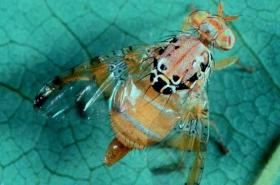Bactrocera cucurbitae, Dacusspp. and Ceratitis capitata
Credits:Biovision-Infonet

(c) R. C. Copeland, icipe
Fruit flies are important pests of cucurbits including pumpkins. Fruit flies pierce the fruits and lay eggs in them. The fruit fly maggots feed inside the fruit causing sunken, discoloured patches, distortions and open cracks. These cracks serve as entry points for fungi and bacteria, which cause fruit rot.
What to do:
- Avoid continuous cultivation of cucurbits at the same place.
- Destroy all infested fruit.
- Wrap or bag individual fruits with newspaper or paper bags to prevent fruit flies from laying eggs on the fruit. Wrapping or bagging should be started shortly after fruit set.
- Spray with a pyrethrum solution in the evenings after the bees are mostly back in their hives (after 6 pm). There is a product commercially available called “Flower-DS”, made of natural pyrethrum and acceptable in organic certified systems (see Hygrotech Company, contact-addresses below).- Precautions: Be careful to spray late in the evening, follow the spraying instructions. Wear masks and skin protection.All insect poisons are also poisonous to humans even if coming from natural sources.-
- Frequency of spraying: start shortly after beginning of flowering, and repeat approx every 5 days or according to counts.
- Frequent applications of neem can keep fruit fly attack to a minimum.